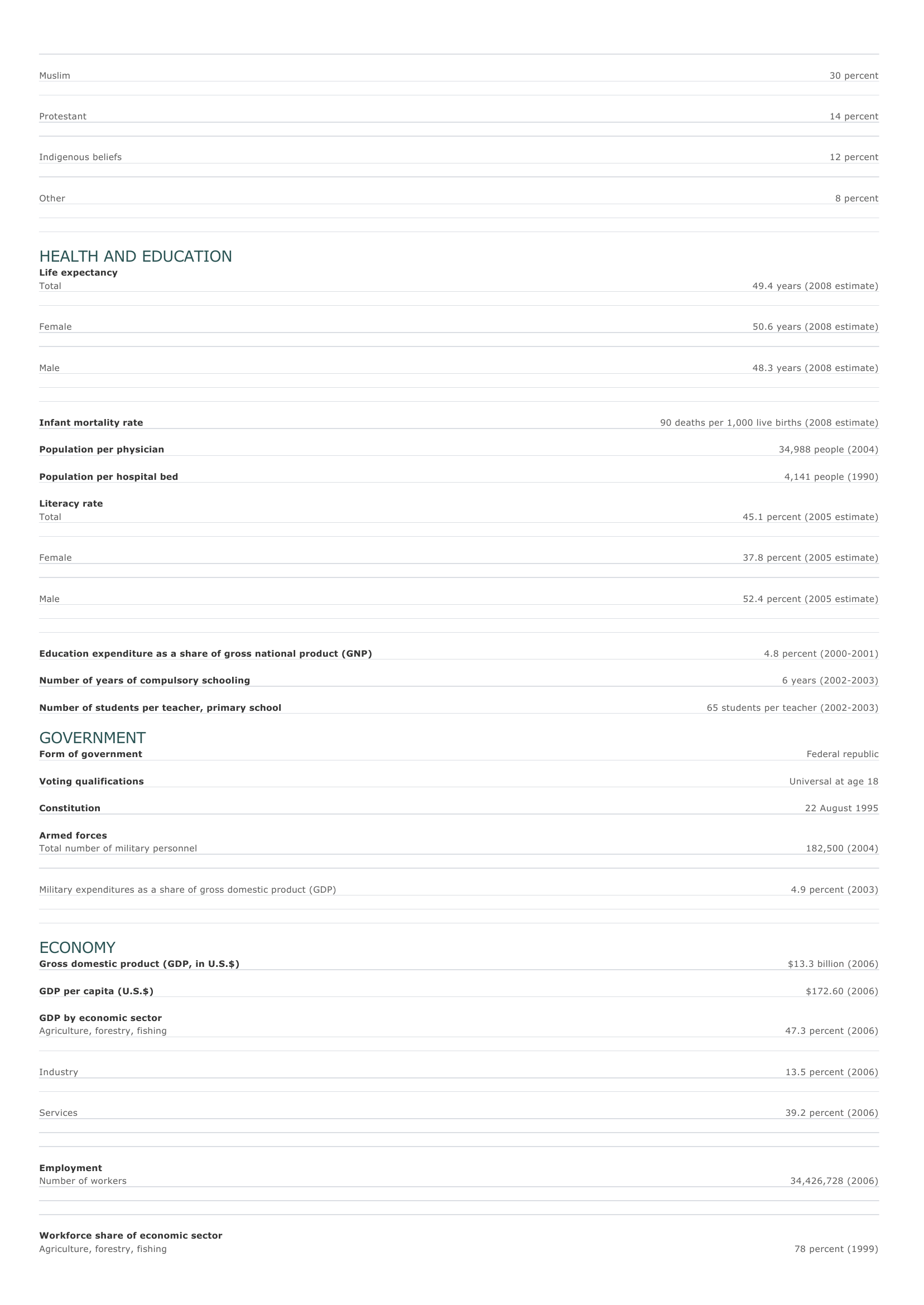Ethiopia Facts and Figures. BASIC FACTS Official name Capital Area Federal Democratic Republic of Ethiopia Addis Ababa 1,133,380 sq km 437,600 sq mi PEOPLE Population 78,254,090 (2008 estimate) Population growth Population growth rate 2.23 percent (2008 estimate) Projected population in 2025 107,804,235 (2025 estimate) Projected population in 2050 144,716,331 (2050 estimate) Population density 70 persons per sq km (2008 estimate) 181 persons per sq mi (2008 estimate) Urban/rural distribution Share urban 16 percent (2005 estimate) Share rural 84 percent (2005 estimate) Largest cities, with population Addis Ababa 2,723,000 (2003 estimate) Dir? Dawa 227,494 (2001 estimate) Nazr? t 180,537 (2001 estimate) G onder 156,087 (2001 estimate) H? rer 101,000 (2001 estimate) Ethnic groups Oromo 40 percent Amhara, Tigrean 32 percent Sidamo 9 percent Shankella 6 percent Somali 6 percent Afar 4 percent G urage 2 percent O ther 1 percent Languages Amharic (official), Tigrinya, Tigre, Orominga, Ge'ez, Gurage, Somali, Arabic, English Religious affiliations Orthodox Christian (Ethiopian) 36 percent Muslim 30 percent Protestant 14 percent Indigenous beliefs 12 percent O ther 8 percent HEALTH AND EDUCATION Life expectancy Total 49.4 years (2008 estimate) Female 50.6 years (2008 estimate) Male 48.3 years (2008 estimate) Infant mortality rate Population per physician Population per hospital bed 90 deaths per 1,000 live births (2008 estimate) 34,988 people (2004) 4,141 people (1990) Literacy rate Total 45.1 percent (2005 estimate) Female 37.8 percent (2005 estimate) Male 52.4 percent (2005 estimate) Education expenditure as a share of gross national product (GNP) Number of years of compulsory schooling Number of students per teacher, primary school 4.8 percent (2000-2001) 6 years (2002-2003) 65 students per teacher (2002-2003) GOVERNMENT Form of government Federal republic Voting qualifications Universal at age 18 Constitution 22 August 1995 Armed forces Total number of military personnel 182,500 (2004) Military expenditures as a share of gross domestic product (GDP) 4.9 percent (2003) ECONOMY Gross domestic product (GDP, in U.S.$) GDP per capita (U.S.$) $13.3 billion (2006) $172.60 (2006) GDP by economic sector Agriculture, forestry, fishing 47.3 percent (2006) I ndustry 13.5 percent (2006) Services 39.2 percent (2006) Employment Number of workers Workforce share of economic sector Agriculture, forestry, fishing 34,426,728 (2006) 78 percent (1999) I ndustry 6 percent (1999) Services 16 percent (1999) Unemployment rate 23.1 percent (2004) National budget (U.S.$) Total revenue $1,606 million (2002) Total expenditure $1,110 million (2002) Monetary unit 1 birr (Br), consisting of 100 cents Major trade partners for exports Djibouti, Italy, Japan, Saudi Arabia, and Germany Major trade partners for imports Saudi Arabia, Italy, China, India, and Germany ENERGY, COMMUNICATIONS, AND TRANSPORTATION Electricity production Electricity from thermal sources Electricity from hydroelectric sources Electricity from nuclear sources Electricity from geothermal, solar, and wind sources Number of radios per 1,000 people 1.08 percent (2003 estimate) 98.87 percent (2003 estimate) 0 percent (2003 estimate) 0.05 percent (2003 estimate) 200 (2000 estimate) Number of telephones per 1,000 people 9 (2005) Number of televisions per 1,000 people 6 (2000 estimate) Number of Internet hosts per 10,000 people Daily newspaper circulation per 1,000 people Number of motor vehicles per 1,000 people Paved road as a share of total roads 0.01 (2002) 0.4 (1998) 2 (2003) 13 percent (2006) SOURCES Basic Facts and People sections Area data are from the statistical bureaus of individual countries. Population, population growth rate, and population projections are from the United States Census Bureau, International Programs Center, International Data Base (IDB) (www.census.gov). Urban and rural population data are from the Food and Agriculture Organization (FAO) of the United Nations (UN), FAOSTAT database (www.fao.org). Largest cities population data and political divisions data are from the statistical bureaus of individual countries. Ethnic divisions and religion data are largely from the latest Central Intelligence Agency (CIA) World Factbook and from various country censuses and reports. Language data are largely from the Ethnologue, Languages of the World, Summer Institute of Linguistics International (www.sil.org). Health and Education section Life expectancy and infant mortality data are from the United States Census Bureau, International Programs Center, International database (IDB) (www.census.gov). Population per physician and population per hospital bed data are from the World Health Organization (WHO) (www.who.int). Education data are from the United Nations Educational, Scientific and Cultural Organization (UNESCO) database (www.unesco.org). Government section Government, independence, legislature, constitution, highest court, and voting qualifications data are largely from various government Web sites, the latest Europa World Yearbook, and the latest Central Intelligence Agency (CIA) World Factbook. The armed forces data is from Military Balance. Economy section Gross domestic product (GDP), GDP per capita, GDP by economic sectors, employment, and national budget data are from the World Bank database (www.worldbank.org). Monetary unit, agriculture, mining, manufacturing, exports, imports, and major trade partner information is from the statistical bureaus of individual countries, latest Europa World Yearbook, and various United Nations and International Monetary Fund (IMF) publications. Energy, Communication, and Transportation section Electricity information is from the Energy Information Administration (EIA) database (www.eia.doe.gov). Radio, telephone, television, and newspaper information is from the United Nations Educational, Scientific and Cultural Organization (UNESCO) database (www.unesco.org). Internet hosts, motor vehicles, and road data are from the World Bank database (www.worldbank.org). Note Figures may not total 100 percent due to rounding. Microsoft ® Encarta ® 2009. © 1993-2008 Microsoft Corporation. All rights reserved.






